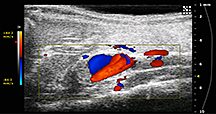Very Bright Blue and Red on Abdominal Ultrasound
Ultrasound revealing secrets of deadly abdominal aortic aneurysms
October 15, 2014
 |
| Purdue University researchers are using ultrasound images like this one to study abdominal aortic aneurysms, a potentially fatal condition that is the 13th leading cause of death in the United States. (Purdue University photo/Weldon School of Biomedical Engineering) |
WEST LAFAYETTE, Ind. — Researchers are exploring the usefulness of ultrasound imaging to study dangerous abdominal aortic aneurysms, a bulging of the aorta that is usually fatal when it ruptures and for which there is no effective medical treatment.
Abdominal aortic aneurysms are the 13th leading cause of death in the United States, killing about 15,000 annually.
"Most of the time people don't even know it's there, but if it does rupture they have internal bleeding from the largest artery in the body," said Craig Goergen, an assistant professor in Purdue University's Weldon School of Biomedical Engineering. "Eighty percent of the time the patient dies before getting to the hospital."
Researchers have used a method called high-frequency small animal ultrasound to measure changes in the progression of abdominal aortic aneurysms in laboratory animals. By learning more about aneurysms at the molecular level, researchers might be able to develop drug or stem cell therapies to keep them from growing larger, said Goergen (pronounced Gor-Jen).
New findings will be detailed in a paper to be presented on Oct. 25 by doctoral student Evan Phillips during the Biomedical Engineering Society's annual meeting in San Antonio.
The researchers are able to track small changes in the vessel as the aneurysm forms. Ultrasound imaging allows for visualization of the arterial layers that often separate from each other while the vessel grows.
"The development of these aneurysms is a multifaceted process that has not been fully characterized, and no therapeutics have proven to effectively prevent aneurysm progression," Goergen said. "What we want to do is understand what causes aneurysms to form and grow so that we can then develop better strategies to prevent that from happening."
The ultrasound technique also uses color Doppler imaging, making it possible for researchers to collect color-coded blood flow data showing the direction and speed of circulation, both of which are factors that might influence how aneurysms develop and expand. The frequency of a wave changes as it moves toward or away from the observer, a phenomenon known as the Doppler effect. Color Doppler images show red flow moving toward the ultrasound transducer and blue flow moving away.
The efforts are laying a foundation for future studies that might use these methods in a clinical setting or to investigate potential therapeutics, he said.
Human aortic aneurysms typically begin at 3 to 4 centimeters in diameter and are located in the abdomen below the kidneys. The aorta extends from the heart through the body and finally branches into two smaller arteries leading to the legs.
Most at risk are elderly men who have high blood pressure and a history of smoking. Men over 65 who fit this profile are recommended to contact their doctor about ultrasound screening to determine if they have an aneurysm.
"Unless you feel a pulsating mass, develop unusual back pain, or are screened with ultrasound, most people don't even discover that they have it. If you are diagnosed, most surgeons won't treat aneurysms less than 4 centimeters. Unfortunately, there is no medicine that can prevent aneurysms from growing," Goergen said. "Doctors can give you statins to lower your cholesterol levels or anti-hypertension medication to lower your blood pressure, but there are no medications that can directly prevent aneurysm expansion."
However, researchers can study laboratory animals that mimic conditions in humans to provide insights into the mechanisms behind aneurysms. The group led by Goergen used ultrasound imaging to quantify changes over a 4-week period as aneurysms developed and expanded in mice and rats.
"We're doing three-dimensional ultrasound that can reconstruct that whole aorta," Goergen said.
Because this technique is non-invasive, it might eventually be used on humans to diagnose and track aneurysm progression.
The conference paper is authored by Phillips, undergraduate students Alexa Yrineo and Hilary Schroeder; doctoral student Frederick Damen; undergraduate students Amy Bogucki, Shadman Jubaer, Amelia Adelsperger and Rebecca Foley; postdoctoral fellow Ashley Nicole Blaize; Ji-Xin Cheng, a professor in the Weldon School of Biomedical Engineering and Department of Chemistry; and Goergen. Katherine Wilson, an undergraduate biomedical engineering student at the University of Arkansas, also participated in the research through the Summer Undergraduate Research Fellowship (SURF) program.
Writer: Emil Venere, 765-494-4709, venere@purdue.edu
Source: Craig J. Goergen, 765-494-1517, cgoergen@purdue.edu
ABSTRACT
Development and Application of Ultrasound Techniques for Investigating Pathogenesis in Experimental Abdominal Aortic Aneurysms
E. Phillips, A. Yrineo, H. Schroeder, F. Damen, A. Bogucki, S. Jubaer, A. Jackson, R. Foley, N. Blaize, J-X. Cheng, and C. Goergen
Abdominal aortic aneurysms (AAAs) are pathological dilations of the aorta associated with significant morbidity and mortality due to rupture. AAA development is a multifactorial process that has not been fully characterized and no therapeutics have proven to effectively prevent aneurysm progression. However, rodent models that mimic the human condition have been developed providing insight into mechanisms of pathogenesis. The purpose of this study is to quantify anatomical and biomechanical changes occurring during aneurysm progression using advanced in vivo and ex vivo imaging techniques in rodent AAA models.
Source: https://www.purdue.edu/newsroom/releases/2014/Q4/ultrasound-revealing-secrets-of-deadly-abdominal-aortic-aneurysms.html
0 Response to "Very Bright Blue and Red on Abdominal Ultrasound"
Post a Comment